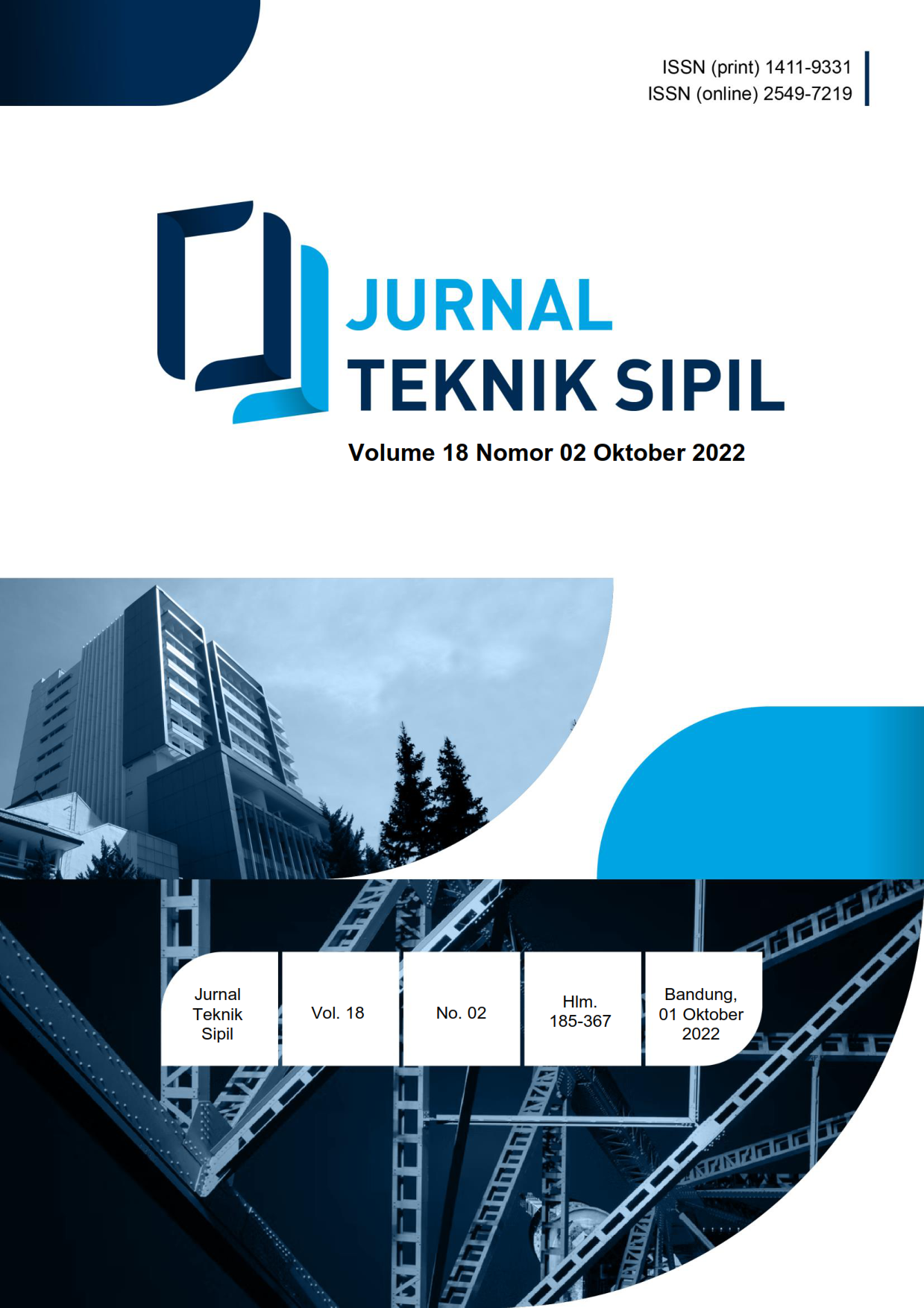THE EFFECT OF PERMEABILITY ON SAFETY OF GUNUNGROWO DAM STABILITY
DOI:
https://doi.org/10.28932/jts.v18i2.4648Keywords:
Safety Factor, Seepage, SEEP/W, SLOPE/W, Core Permeability VariableAbstract
Gunungrowo Dam has been establishing in 1925, it is located on the Wadi River. This dam is a homogeneous earthfill dam with a height of 20.5 m, with a storage capacity of 5.11 million m3 to supply irrigation water for an area of 6,000 Ha. Because the operational period is approaching 100 years, it is necessary to evaluate the level of stability and safety of the dam. The purpose of this study was to 1) determine the stability of the seepage safety in various reservoir water levels; 2) determine the slope safety stability (Safety Factor) of the dam in various reservoir water level conditions; 3) determine the effect of the dam body core permeability variable on seepage, and 4) determine the effect of the dam body core permeability variable on slope stability. The main discussion in this study is to analyze the stability of the dam safety using the GeoStudio-2012 computer program with SEEP/W features on seepage discharge and SLOPE/W on SF (Safety Factor) slopes. The SEEP/W modeling uses the concept of saturated soil mechanics. The input parameters for slope stability analysis are dam dimensions, type of material, bulk density (γ), cohesion (c), and shear angle (j). The study was conducted on all seepage discharge values and all SF values at minimum water level, normal water level, flood water level and fast receding with calculations without earthquake loads. The results of the study obtained that the SF value, discharge value, stable against landslide hazards and piping hazards met the safety requirements. Furthermore, from the seepage discharge value and the SF value, it is studied how the influence of the dam core permeability variable on the piping hazard and the potential for landslide hazard. From the results of the analysis, it is concluded that the greater the value of the permeability, the greater the seepage discharge and the greater the value of the permeability, the smaller the value of the safety factor.Downloads
References
Al-Mansori, N. J. H., Al-Fatlawi, T. J. M., Othman, N. Y., & Al-Zubaidi, L. S. A. (2020). Numerical analysis of seepage in earth-fill dams. Civil Engineering Journal (Iran), 6(7), 1336–1348. https://doi.org/10.28991/cej-2020-03091552
Badan Standardisasi Nasional. (2016). Metode Analisis Stabilitas Lereng Statik Bendungan Tipe Urugan.
BBWS Pemali-Juana. (2018). Laporan Akhir Pemeriksaan Besar Bendungan Gunungrowo, Kabupaten Pati, Direktorat Jenderal Sumber Daya Air, Kementerian Pekerjaan Umum dan Perumahan Rakyat.
Dinas PSDA Provinsi Jawa Tengah. (2017). Peta Lokasi Waduk di Propinsi Jawa Tengah.
Feryadi, A., & Gofar, N. (2022). Effect of Changing in Free Water Level on the Stability of River Embankment. Jurnal Teknik Sipil, 18(1), 33–50. https://doi.org/10.28932/jts.v18i1.3933
GEO-SLOPE International Ltd. (2012a). Seepage Modeling with SEEP / W 2015. Geostudio HelpfileSeepage Modeling with SEEP / W, July, 199. http://www.geo-slope.com
GEO-SLOPE International Ltd. (2012b). Stability modeling with Slope/W. Stability Modeling with Slope/W, June, 213. http://www.eng.uwo.ca/people/tnewson/Lectures/SLOPEW Engineering Book.pdf
Kristo, C., Rahardjo, H., & Satyanaga, A. (2019). Effect of hysteresis on the stability of residual soil slope. International Soil and Water Conservation Research, 7(3), 226–238. https://doi.org/10.1016/j.iswcr.2019.05.003
Lontoh, R. J., Manoppo, F. J., & Sompie, O. B. A. (2020). Analisa Kestabilan Bendungan Lolak 1. Jurnal Sipil Statik, 8(2), 221–236.
Nugraha, A. S., & Sutanto, A. K. (2019). PENGARUH SUDUT KEMIRINGAN LERENG TERHADAP ANGKA STABILITAS LERENG TANAH KOHESIF BERDASARKAN KURVA TAYLOR DAN SOFTWARE GEO5. Jurnal Teknik Sipil, 15(2), 87–99. https://doi.org/10.28932/jts.v15i2.1958
Putra, T. G. S., Aribudiman, I. N., & Juliawan, G. R. (2019). Analisis Stabilitas Lereng Pada Bendungan Titab. Jurnal Ilmiah Teknik Sipil, 20(1), 1689–1699.
Rahardjo, H., Nio, A. S., Harnas, F. R., & Leong, E. C. (2014). Comprehensive Instrumentation for Real Time Monitoring of Flux Boundary Conditions in Slope. Procedia Earth and Planetary Science, 9, 23–43. https://doi.org/10.1016/j.proeps.2014.06.015
Rahardjo, H., Satyanaga, A., & Leong, E. C. (2016). Effects of Rainfall Characteristics on the Stability of Tropical Residual Soil Slope. E3S Web of Conferences, 9, 15004. https://doi.org/10.1051/e3sconf/20160915004
Satyanaga, A., Wijaya, M., Zhai, Q., Moon, S.-W., Pu, J., & Kim, J. R. (2021). Stability and Consolidation of Sediment Tailings Incorporating Unsaturated Soil Mechanics. Fluids, 6(12), 423. https://doi.org/10.3390/fluids6120423
Downloads
Published
How to Cite
Issue
Section
License
Copyright (c) 2022 Afrizon Kamiruddin, Abdul Chalid , Agus Sulaeman , Chandra Afriade Siregar

This work is licensed under a Creative Commons Attribution-NonCommercial 4.0 International License.















